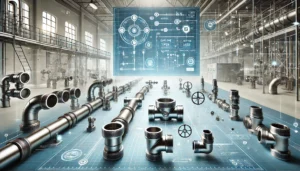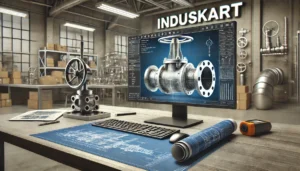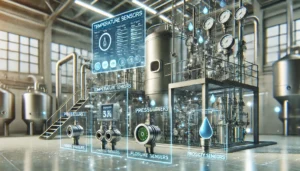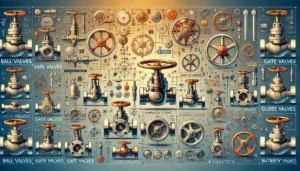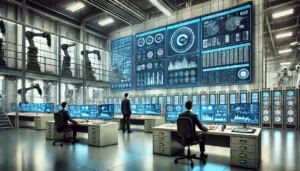When choosing pipe fittings in corrosive regions, the most important aspects to consider are safety, efficiency, and the lifespan of the plumbing system. Fitting selection failure may result in system malfunction, larger environmental issues, or excessive upkeep costs, so it is imperative to know the material’s traits and factors that impact its selection for making good choices as engineers and system designers.
What Is Considered Corrosive Environments?
Corrosive environments are defined by aggressive elements that can wear down materials with time. Such conditions can be found in wastewater treatments, chemical processing, and marine industries. Key factors that cause corrosive conditions include:
- Chemical Exposure : The presence of acids, bases, salts, or other reactive chemicals
- Extremes in Temperature: Very high or low temperatures can speed up the corrosion phenomenon.
- Changes in Pressure: Stress corrosion cracking can be triggered with pressure changes.
- Microbial Activity: Certain bacteria can induce corrosion, known as microbiologically influenced corrosion (MIC).
Factors Influencing Material Selection
The elimination of these threats as much as possible is crucial in solving the problem of choosing pipe fittings:
- Chemical Compatibility: The selected material cannot simply break down against the chemicals it is likely to come in contact with. While some materials are more resistant to certain chemicals, others are much more prone to suffer damages will load-bearing acids, salts, and bases.
- Conditions of Temperature and Pressure: The material should not degrade at any given operating temperature and pressure ranges of the system.
- Mechanical Properties: The challenges to be analyzed here involve the material’s strength, fitness, and resistance to stress corrosion cracking under severely adverse environmental conditions.
- Fabrication and Maintenance: Ease with which the fabrication, installation, welding and subsequent maintenance can be performed should be taken into account to ensure long term reliability of the system.
- Cost and Availability: Performance criteria, available funds, and material cost should be properly aligned to guarantee project feasibility.
Common Materials for Corrosive Environments
- Stainless Steel 316 (SS316): Stainless Steel 316 SS is utilized in the manufacturing of production equipment because it is particularly resistant to corrosion as well as edge attack in the presence of chlorine. It is used in food processing, pharmacy, and chemical industries because it has high strength, toughness, resistance to rust, and is synthesized to withstand a very tough environment.
- Polyvinylidene Difluoride (PVDF): It is used in strongly aggressive mediums due to its exceptional chemical resistance and broad operational temperature range. Its non-reactiveness allows the fluids being transported to retain their purity, thus making it an ideal element for use in the pharmaceutical, food, and chemical industries. As an element of PVDF, it is widely used in the fully hostile environment because of its ability to resist chemicals and its very high operational temperature range.
- Polypropylene (PP): The toughness of Polypropylene (PP) fittings is commendable and the chemical resistance is outstanding as well. Therefore, their application is practical in sewage, chemical processing industries, and even in household functions. It works best in systems that deal with highly aggressive chemicals, as well as for mid-range temperature fluids.
- Polyvinyl Chloride (PVC): PVC is one of the most used materials in piping structure because it withstands numerous acids and bases, salts, paraffinic hydrocarbons, and even some halogens. Its uses extend in water treatment facilities, drainage, and in some chemical systems. Solvents and aromatics are not ideal for it, but it is a reasonable and reliable option in less hostile situations.
- Ductile Iron: Ductile iron fittings are known for their impressive strength and traits, which make them ideal for places with strong internal corrosion. These fittings are especially favorable in water systems where iron provides superiority over other materials which corrode over time. Ductile iron pipes are coated with a protective layer that reduces the chances of external corrosion, making systems and structures last longer.
Corrosion Mitigation Strategies
The life span of corrosion threatened pipe fittings can be increased with the following corrosion mitigation strategies:
- Protective Coatings: Coatings such as epoxy, polyurethane, and zinc can be used to fit pipes and create a barrier against corrosive chemicals. Protective coatings are sometimes applied to prevent internal and external sources of corrosion.
- Cathodic Protection: Using sacrificial anodes or impressed current systems, corrosion can in fact be prevented. Cathodic protection helps protect the fitting and related components from damage and is useful in more severe conditions.
- Regular Maintenance and Monitoring: Periodic inspection of systems allow for early detection of corrosion which is timely manageable. These monitoring systems are capable of measuring and monitoring performance of the piping system to prevent advancement of problems that have happened in the past.
- Environmental Control: If applicable, environmental factors such as humidity, temperature, and aggressive chemical exposure should be controlled in order to assist limiting the corrosion rate. For example, pipes do not need to be exposed to the sun directly in order to help assist UV degradation on certain materials.
Conclusion
Choosing the right pipe fittings in corrosive environments is essential for maximizing the life span and effectiveness of any industrial piping system. When engineers design a system, they must take into account all the reasons that induced corrosion, material characteristics, and the corrosion prevention measures that have to be utilized to make the system robust, consistent, and safe. Stainless steel and even modern day plastics like PVDF are among the materials that help reduce the chances of corrosion and enhance the lifespan of the system. Every industry needs to factor all of the system’s unique needs in order to reduce expensive maintenance costs, improve safety, and protect their equipment over the long term.


